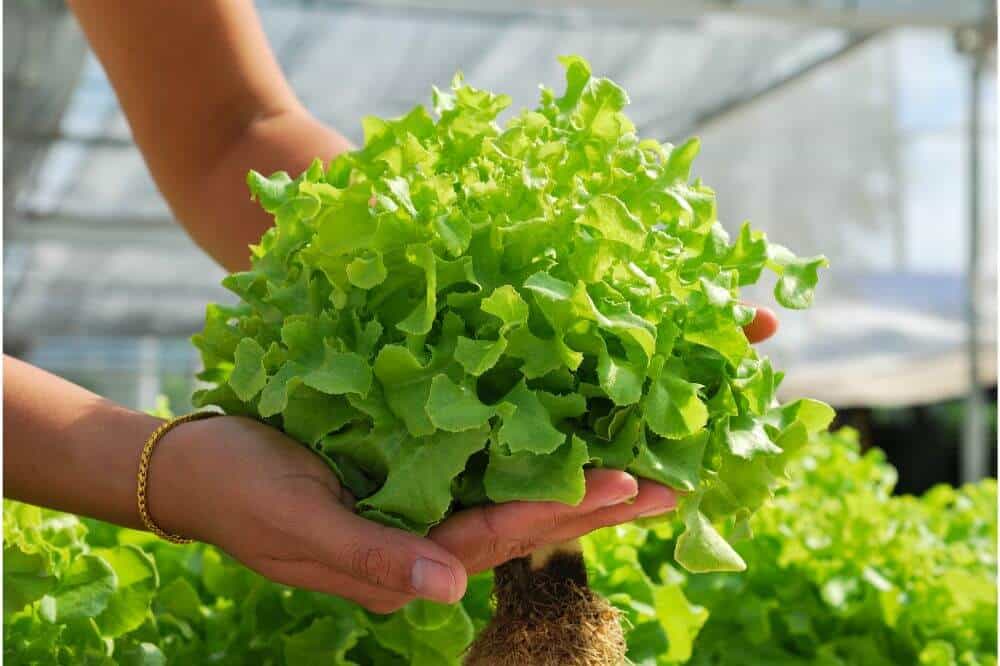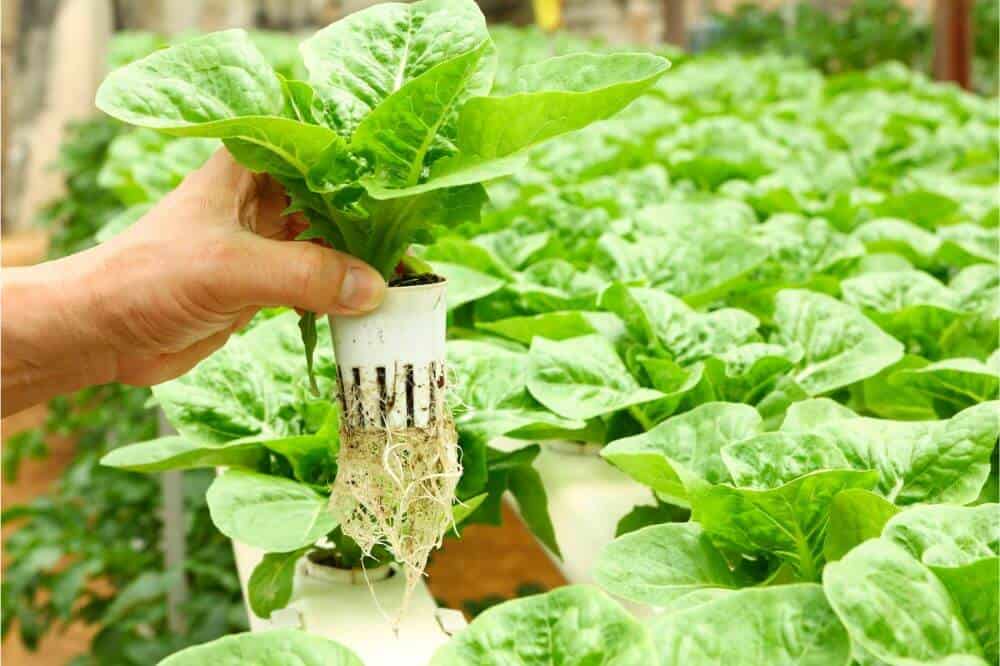There are a lot of benefits of growing with hydroponics, but none of them will matter unless you use the proper food and water as well as a proper feeding schedule.
In fact, once you are done building your hydro garden, you will need to figure out what works best for you and your plants.
Hydroponics Feeding Schedule
We are going to take a look at what you should be feeding and watering with, as well as give a general hydroponics feeding schedule (your schedule may differ a little depending on the plant, but this schedule will be a good place to start) that will help you end up with a high yield of healthy plants.
But first what is hydroponics?
Why grow hydroponically?
And what tools will you need to execute this general feeding schedule?

What is Hydroponics?
If you are just starting out and doing a little research, you may want to understand what hydroponics is. This a method of cultivating plants by using a water-based system, coupled with nutrients.
There is no soil used; instead, in the planters, you will use a plant medium like Perlite to act as the plant’s root bedding.
The roots of the plant will be in direct contact with the nutrients that are delivered into the water reservoir, which in turn stimulates growth. Learn more about growing with hydroponics vs soil.
Why Grow Hydroponically?
There are many pros (and some cons) that come with growing your plants hydroponically. So, with that said, before we get into the feeding process, let us take a quick look at them, so you know what you are facing.
Hydroponics Pros
- Increased growth rate (+25 % faster)
- Plants will grow larger due to their not having to struggle to get to the nutrients they need to grow.
- It conserves water through the recycling of water from its enclosed set-up.
- It creates a sustainable and eco-friendly system to grow your plants. Less waste and pollution are created by runoff from the soil.
Hydroponics Cons
- The set-up and maintenance of the system may cost more than the traditional way of growing.
- It takes more time to set-up and maintain than using a soil-based system.
- A high risk of failure due to relying on mechanical systems that may malfunction or break. Having a generator can ensure backup power if there is a power outage.
Knowing the basics is important to understanding the whole construct of hydroponic growing. So, armed with a little basic knowledge, let’s look at the tools you will need to have with you in preparation for the feeding cycle.
Best Hydroponic Nutrients for a Bountiful GrowBest Plants for Hydroponics: Top 7 Edible Plants
Hydroponics Tools You Will Need
Knowing when to feed will be no good to you if you do not have the right tools to do it. So, here are a few things you will need to have on hand when getting ready to serve dinner to your plant children:
pH tester
You will want to make sure the pH of your water is perfectly suited for growing. To do this, making sure that you have a pH tester handy is a great idea. Poorly balanced pH can cause a lot of problems you do not want to deal with.
Measuring spoons
This will be used to divvy up the nutrients and Epsom salts to build your feed solution.
Nutrients
You can buy many types and should make sure that the ones you choose are designed for growing in a hydroponics atmosphere.
Epsom salts
You will want to add ¼ of a teaspoon in every feeding of Epsom salts. This will help with the magnesium levels and in turn, help with growth.
Water
A container of water will help you dissolve the nutrients and Epsom salts before adding it to your plants, so it is easier to absorb.
Okay, now you know what you need to gather together to get ready to feed your plants properly, let us look at what and why you need to feed them.
What to Feed (and Water) Your Plants With
With the proper tools at hand, you are ready to start the process of choosing the right nutrients to use when feeding your plants. Just as important as that is the water you use in the entire process.
There are other factors like temperature and lights, but those will not impact the feeding schedule but rather the entire grow cycle.
All the factors combine to create the perfect growing environment, so let’s look at the two chief components in the feeding process.
Hydroponics Water
Making sure you use the highest quality water, both in the reservoir as well as when watering, is crucial to the health of your plants.
Using water from the tap or other sources that have not been distilled can lead to issues with overfeeding by introducing nutrients from an outside source you are unaware of.
You will want to use the best filtered water possible. To do this, we suggest using a multi-level filtration system that takes the water through its paces before expelling it into your reservoir and misting system.
This will negate any chance that stray salt, chemicals or nutrients make their way into the water before you adding them yourself.
Hydroponics Feed Nutrients
There are many nutrients available for growing plants, but the first thing you will need to pay attention to is that you are getting one specifically crafted for work with hydroponics.
The typical nutrients you may get from simple soil growth will be lacking certain key nutrients as they rely on the soil to lead a bit of help.
When you are growing hydroponically, you will not have that assist so you will need your interest to cover everything you are losing from not having soil.
There are two styles you have:
- Liquid – The liquid is easier to use but can be a bit pricey.
- Dry options – The dry option is cheaper and requires a few extra steps to get it ready for delivery.
Once you have chosen the nutrient that seems like it will work for you and your plants, you will want to (if dealing with dry nutrients) also pick up those Epsom salts we talked about in the tools section.
Once you have all your gear together, you are ready to start developing your feeding schedule and starting the rowing process.
Feeding Schedule
The hydroponics feeding schedule will depend on many factors. They are:
- How large your plants are
- What type of hydroponics system you are using
- For example, if using an ebb and flow system, you will also need to factor in the size of the growing tray
- What growing medium or substrate you are using as some are more absorbent than others
Understanding the importance of both the nutrients and the water is key in making your hydroponics crop come to fruition the way you envision.
Making sure you never over water and keep clean water flowing through the system is essential.
But to ensure the plants grow the way you want means feeding them on the right schedule with the nutrients that work for them.
The first thing that you should do is pay close attention to the suggested feeding schedule given to you from the nutrient’s manufacturers. This means not skipping feedings and giving dosages indicated on the bag.
The only time you should vary from that schedule is if you see adverse effects.
Once you have done this, you will find that your schedule may be slightly different than the one the nutrients manufacturers suggested.
So that you have an idea of a good general feeding schedule for your hydroponics we have put together one (note this is just a general and may not work for all plants or hydroponic gardens, not every nutrient mix):
- 1st week = 5ml
- 2nd week = 10ml
- 3rd week = 10ml
- 4th week = 10ml
The remaining schedules are all 10ml.
Even with this general feeding schedule, we still highly suggest following the nutrients chart available on whatever brand you use for the best results.
Some Tips to Help Your Plants Grow
Once you have the water, feed, and schedule down, there are a few other essential factors that play a key role in the success of a hydroponics garden.
So, we thought we would give you a few small tips that may help you out even more.
Tips to Help Plants Grow
- You will want to make sure that your plants get at least 6 hours of sunlight (or grow light) a day.
- If you want to make things a little easier, start with a plant that has already begun the growing process.
- Make sure to check the pH and adjust accordingly and regularly.
- Make sure your pump timer is set for the perfect cycle.
Final Thoughts on General Hydroponics Feeding Schedule
In the end, the schedule that best suits you will be the one that takes into consideration everything from the plant’s you are growing, to your hydroponic set-up, to your climate, and everything in between.
Once you have decided all of that, you can begin to craft the perfect feed schedule for your own individual needs. Starting with the suggested schedule, you will want to pay close attention to the plant looking for signs of both over and underfeeding.
If you are overfeeding, you may see your plants wilting or turning yellow, slow growth or even leaves dropping off.
If you are underfeeding, you may see the same issues arise. So carefully adjusting your feeding schedule will help you combat either problem
DIY Hydroponic System and Hydroponic Garden
Building DIY Hydroponic PVC System Using PVC
Building DIY Hydroponic Systems
Complete Guide to Lettuce Hydroponics and What to Buy

